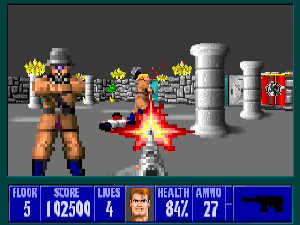We will move from the introduction of sprites to the introduction of 3D graphics in games with this post. While this seems like a bit of a jump, it’s definitely worth exploring as 3D graphics define many of today's games, with increasingly realistic environments.
One could make an argument that scaling sprites based on their distance to the player and vector-based graphics have made 3D gaming possible for a long time. An example of a game that tried to make early use of 3D-style graphics is Atari’s Battlezone, released in November of 1980 as an arcade cabinet. Battlezone took the vector-based approach, as seen below:
Figure 1. Atari’s Battlezone, released in 1980. An early example of a 3D-style game using wireframe vector graphics (FunCade 64, 2017, 0:11).
However, games with fully-rendered 3D environments – even simple ones – were a bit out of reach for the hardware of the time period. Of course, this didn’t stop anyone from making games that toyed with the concept of a 3D perspective. An early example of this would be 3D Monster Maze, first released for the Sinclair ZX81:
Figure 2. 3D Monster Maze for the Sinclair ZX81, released in 1982. The walls appear 3D, but the T-Rex doesn’t, though it does grow larger as it approaches (Evans, 1981).
3D Monster Maze is one of the earliest examples of a game that takes a “2.5D” perspective. The walls and surroundings take on a 3D appearance scaling as they get “further away,” while enemies and powerups appear as 2D sprites.
A better-known example of a game that takes on a 2.5D perspective is Wolfenstein 3D. The walls were drawn using a ray casting algorithm while the enemies were flat bitmap graphics, scaled based on their distance from the player:
Figure 3. Id Software’s Wolfenstein 3D, released on May 5, 1992. Many of the concepts from 3D Monster Maze are apparent (Id Software, 1992).
This approach of 3D-rendered walls combined with scaled flat enemies persisted in many games for home PCs and video game consoles, such as in 1993’s Doom:
Figure 4. Id Software’s Doom, released on December 10, 1993. The walls and floor are rendered using a better algorithm than Wolfenstein 3D, but the flat and scaled enemies remain (Id Software, 1993).
By now, there were indeed games that used 3D graphics with polygonal players and enemies. A striking example of this is the arcade title Virtua Racing:
Figure 5. Sega’s Virtua Racing, released in 1992; this is the arcade version, though a graphically-reduced version for the Sega Genesis/Mega Drive was also released (VideoGamerJunkie, 2012, 0:57).
If you take a close look, however, you’ll notice that all of the polygons are flat-colored; there aren’t any textures being applied! The early 90s were too early to have games that were both fully-rendered and textured.
By the mid-to-late 90s, Quake had been released on home PCs, and consoles designed with 3D in mind like the Sony PlayStation and Nintendo 64 were mainstream.
Figure 5. Super Mario 64, one of the most popular 3D games of the mid-90s, with 3D NPCs, players, and environments (Nintendo EAD, 1996).
Figure 6. Quake, by Id Software, one of the earlier and more popular fully textured and rendered games (Id Software, 1996).
These more recent examples are much closer to the many 3D games of today, though modern 3D models have far more complicated meshes and textures, thanks to the ever-increasing might of computer hardware.
References
FunCade 64. (2017, March 6). “Battle Zone (Atari 1980) - AAE (Another Arcade Emulator)” [Video file]. Retrieved November 2, 2017 from https://www.youtube.com/watch?v=w2E8gs6On9Q
Evans, M. (1981) 3D Monster Maze [Image, screenshot]. Retrieved November 2, 2017 from https://upload.wikimedia.org/wikipedia/en/8/83/3D-monster-maze-T-rex-2-steps-away.png
Id Software. (May 5, 1992). Wolfenstein 3D [Image, screenshot]. Retrieved November 2, 2017 from https://upload.wikimedia.org/wikipedia/en/6/69/Wolf3d_pc.png
Id Software. (December 10, 1993). Doom [Image, screenshot]. Retrieved November 2, 2017 from https://upload.wikimedia.org/wikipedia/en/d/de/Doom_ingame_1.png
VideoGamerJunkie. (2012, January 5). “Virtua Racing – Arcade” [Video file]. Retrieved November 2, 2017 from https://www.youtube.com/watch?v=_zxjAEyT7Ng
Nintendo EAD. (June 23, 1996) Super Mario 64 [Image, screenshot]. Retrieved November 2, 2017 from https://www.mariowiki.com/images/thumb/8/81/SM64BobOmbBattlefield.png/236px-SM64BobOmbBattlefield.png
Id Software. (June 22, 1996). Quake [Image, screenshot]. Retrieved November2, 2017 from http://wiki.quakeworld.nu/images/Quake_1_screenshot_320x200_e1m3.png








No comments:
Post a Comment